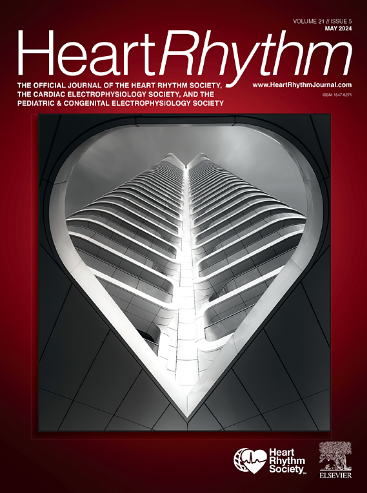Changes in epicardial adipose tissue volume before and after cryoballoon ablation in patients with atrial fibrillation: Supporting the “AF begets EAT” theory
IF 5.6
2区 医学
Q1 CARDIAC & CARDIOVASCULAR SYSTEMS
引用次数: 0
Abstract
Background
Epicardial adipose tissue (EAT) is closely associated with atrial fibrillation (AF), suggesting that it may be one of the causes of AF progression. However, it is unclear whether AF affects EAT.
Objective
This study aimed to demonstrate that sinus rhythm restoration reduces EAT volume (EATV) through left atrial reverse remodeling (LARR).
Methods
We analyzed data from 247 patients who underwent cryoballoon ablation for AF. EATV was assessed by contrast-enhanced computed tomography with a 3-dimensional analysis workstation, evaluating EATV surrounding the entire heart (Total-EATV) and left atrium (LA-EATV) at baseline and 6 months after cryoballoon ablation.
Results
At 6 months, all patients but one with persistent AF were in sinus rhythm. Total-EATV and LA-EATV were both significantly decreased in patients with persistent AF (n = 33; Total-EATV: 148.8 ± 53.3 mL to 142.9 ± 53.5 mL [P = .01]; LA-EATV: 26.8 ± 11.3 mL to 25.2 ± 10.7 mL [P = .01]). No changes were observed in patients with paroxysmal AF (n = 214). Persistent AF was more strongly associated with LARR than paroxysmal AF (odds ratio, 2.34; 95% confidence interval, 1.01–5.44; P = .05). LARR showed an independent correlation with both Total-EATV and LA-EATV reduction (odds ratio, 1.78 [P = .04] and 2.80 [P < .001], respectively).
Conclusion
These findings suggest a novel “AF begets EAT” theory, complementing the previously accepted role of EAT as a cause of AF and supporting the “AF begets AF” mechanism.
心房颤动患者冷冻球囊消融前后心外膜脂肪组织体积的变化:支持 "心房颤动催生脂肪 "理论。
背景:心外膜脂肪组织(EAT)与心房颤动(AF)密切相关,这表明它可能是导致心房颤动恶化的原因之一。然而,心房颤动是否会影响心外膜脂肪组织尚不清楚:本研究旨在证明窦性心律恢复可通过左心房反向重塑(LARR)减少 EAT 容量(EATV):我们分析了 247 名接受冷冻球囊消融术(CBA)治疗房颤患者的数据。使用对比增强计算机断层扫描和三维分析工作站对 EATV 进行评估,评估基线和 CBA 术后 6 个月时围绕整个心脏的 EATV(Total-EATV)和左心房 EATV(LA-EATV):结果:6 个月时,除一名持续房颤患者外,所有患者均处于窦性心律。持续性房颤患者(33 人)的总 EATV 和 LA-EATV 均显著下降(总 EATV:148.8±53.3 至 142.9±53.5 mL,p=0.01;LA-EATV:26.8±11.3 至 25.2±10.7 mL,p=0.01)。在阵发性房颤患者(n=214)中未观察到任何变化。与阵发性房颤相比,持续性房颤与 LARR 的关系更为密切(几率比 [OR]:2.34,95% 置信区间 [CI]:1.01-5.44,P=0.05)。LARR与Total-EATV和LA-EATV的减少均呈独立相关性(OR:1.78,P=0.04;OR:2.80,P=0.05):这些发现提出了一种新的 "房颤生EAT "理论,补充了之前公认的EAT作为房颤病因的作用,并支持 "房颤生房颤 "机制。
本文章由计算机程序翻译,如有差异,请以英文原文为准。
求助全文
约1分钟内获得全文
求助全文
来源期刊

Heart rhythm
医学-心血管系统
CiteScore
10.50
自引率
5.50%
发文量
1465
审稿时长
24 days
期刊介绍:
HeartRhythm, the official Journal of the Heart Rhythm Society and the Cardiac Electrophysiology Society, is a unique journal for fundamental discovery and clinical applicability.
HeartRhythm integrates the entire cardiac electrophysiology (EP) community from basic and clinical academic researchers, private practitioners, engineers, allied professionals, industry, and trainees, all of whom are vital and interdependent members of our EP community.
The Heart Rhythm Society is the international leader in science, education, and advocacy for cardiac arrhythmia professionals and patients, and the primary information resource on heart rhythm disorders. Its mission is to improve the care of patients by promoting research, education, and optimal health care policies and standards.
 求助内容:
求助内容: 应助结果提醒方式:
应助结果提醒方式:


